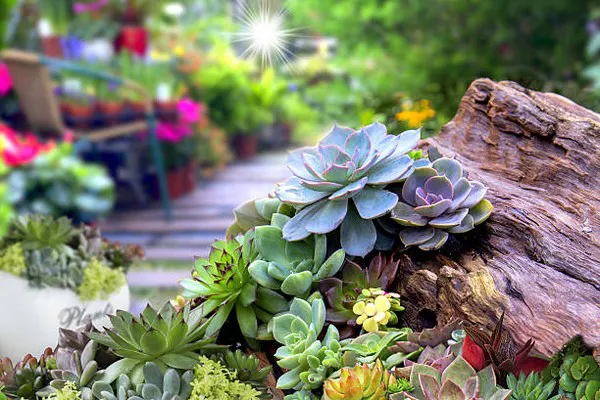Succulents have gained popularity in recent years as trendy, low-maintenance plants that can add a touch of natural beauty to any indoor or outdoor space. However, to keep your succulents healthy and thriving, it’s crucial to understand their unique soil requirements.
Well-Draining Soil for Succulents
The cornerstone of succulent soil is excellent drainage. Succulents are adapted to thrive in arid environments, and their roots are not equipped to handle excessive moisture. Thus, the primary characteristic of succulent soil is its ability to allow water to pass through quickly, preventing the roots from becoming waterlogged. Succulents prefer to be kept on the drier side, which is why well-draining soil is essential.
The key to achieving good drainage in succulent soil lies in the choice of components. Traditional potting soil retains too much moisture for succulents and can lead to root rot. Therefore, succulent soil typically consists of a mix that incorporates materials like perlite, coarse sand, or pumice. These components create air pockets in the soil, ensuring that excess water drains away rapidly.
Avoiding Compaction
In addition to drainage, succulents benefit from soil that does not compact easily. Compacted soil can restrict root growth and aeration, leading to stress and poor succulent health. To prevent soil compaction, avoid using heavy, fine-grained soils or those with high clay content.
Instead, opt for a succulent-specific potting mix or create your own by adding coarse sand, perlite, or crushed granite to a base of regular potting soil. This blend will maintain good soil structure while preventing compaction.
Succulent-Specific Soil Mixes
Ready-made succulent soil mixes are readily available in garden centers and nurseries. These pre-mixed options are designed to meet the specific needs of succulents, making them a convenient choice for both beginners and experienced gardeners.
Succulent-specific soil mixes often include a combination of organic materials like peat or coir to retain some moisture and inorganic materials like perlite, sand, or pumice to enhance drainage. These balanced blends create an optimal environment for succulents, allowing them to thrive while avoiding the pitfalls of overly dense or water-retentive soil.
Creating Your Own Succulent Soil Mix
For those who prefer a hands-on approach to gardening, creating a custom succulent soil mix can be both satisfying and cost-effective. To make your own succulent soil mix, you’ll need a few key components:
Potting Soil: Start with a high-quality potting soil as the base of your mix. Choose one that is well-draining and free of added fertilizers or moisture-retaining agents.
Perlite or Pumice: These lightweight, porous materials are essential for good drainage. They prevent the soil from compacting and allow air to reach the roots.
Coarse Sand: Adding coarse sand further improves drainage while helping to anchor the succulent in the pot.
Optional Ingredients: Depending on your preference and the availability of materials, you can also incorporate crushed granite, turface, or even small pieces of bark to enhance aeration.
Experiment with different ratios of these components to create a succulent soil mix that works best for your specific succulent varieties and growing conditions.
Choosing the Right Pot
In addition to the soil mix, the choice of pot or container can impact your succulent’s health. It’s essential to select pots with drainage holes to facilitate proper water runoff. Succulents do not like sitting in standing water, so pots with drainage holes allow excess moisture to escape, reducing the risk of overwatering and root rot.
Containers made of materials like terracotta or clay are ideal for succulents because they are porous and allow for the exchange of air and moisture. However, other materials such as plastic or ceramic can work well as long as they have drainage holes and are paired with an appropriate succulent soil mix.
Repotting Succulents
Over time, succulents may outgrow their pots, and their soil may become depleted of nutrients. When this happens, it’s essential to repot them to maintain their health and vitality. Repotting also provides an opportunity to refresh the soil.
To repot a succulent, carefully remove it from its current container, gently shake off excess soil, and examine the roots for any signs of rot or damage. Trim away any unhealthy roots before placing the succulent in a slightly larger pot with fresh succulent soil. Water sparingly after repotting and allow the plant to adjust to its new environment.
Conclusion
Succulents are fascinating and versatile plants that can thrive in a variety of environments, provided they have the right soil. Succulent soil should prioritize excellent drainage, aeration, and avoidance of compaction. Whether you choose to purchase a ready-made succulent soil mix or create your own blend, the key is to understand the unique needs of succulents and provide them with an environment that mimics their native habitat.
By selecting the appropriate soil, pot, and adopting good watering practices, you can enjoy the beauty and resilience of succulents in your garden or home. With the knowledge of what succulents need in terms of soil, you’ll be well on your way to cultivating healthy and thriving succulent plants that will bring joy for years to come.


